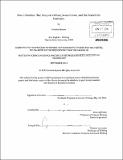| dc.contributor.advisor | Alan Lightman. | en_US |
| dc.contributor.author | Bjoran, Kristina (Kristina Ashley) | en_US |
| dc.contributor.other | Massachusetts Institute of Technology. Graduate Program in Science Writing. | en_US |
| dc.date.accessioned | 2012-01-12T19:30:22Z | |
| dc.date.available | 2012-01-12T19:30:22Z | |
| dc.date.copyright | 2011 | en_US |
| dc.date.issued | 2011 | en_US |
| dc.identifier.uri | http://hdl.handle.net/1721.1/68471 | |
| dc.description | Thesis (S.M. in Science Writing)--Massachusetts Institute of Technology, Dept. of Humanities, Graduate Program in Science Writing, 2011. | en_US |
| dc.description | Cataloged from PDF version of thesis. | en_US |
| dc.description | Includes bibliographical references (p. 39-42). | en_US |
| dc.description.abstract | Humans have long been drawn to the study of nonhuman animal cognitive and emotional intelligence, but have long come up short. Cognitive scientists look for signs of a sense of self, the ability to solve problems, and the capacity for communication in a vast array of nonhuman species, from cephalopods to primates. In this particular search, science has been increasingly successful as researchers report that New Caledonian crows can use tools to solve rather complex problems; that dolphins and songbirds can identify themselves in mirrors; and that dogs can "turn off' survival drives in order to engage in play behavior. In fact, nonhuman animal intelligence research is exploding rather wildly onto the scene. Other scientists aren't as fortunate. They have a much more difficult time identifying with any certainty that nonhuman animals experience emotion, but the answers are approaching illumination. Mice show signs of empathy. Rats laugh when they play...and when intrepid researchers tickle them. Anxious dogs respond identically to humans when fed meat-flavored Prozac. No matter what these behaviors look like, however, emotional experience is subjective and thus still just beyond of scientific reach. As long as subjective experience of nonhuman animals is brushed off by science, the search for evidence of cognitive and emotional intelligence in these creatures is at a hard-headed stand-still. Wrought with fears of anthropomorphism and crushed reputations, these research areas are perpetually at risk for withering away into scientific obscurity. A transformation of thought, a readjustment of methods is deeply needed. A revolution is likely close around the corner, and with it will come a move away from anthropocentric science, as well as some difficult ethical and moral questions. | en_US |
| dc.description.statementofresponsibility | by Kristina Bjoran. | en_US |
| dc.format.extent | 42 p. | en_US |
| dc.language.iso | eng | en_US |
| dc.publisher | Massachusetts Institute of Technology | en_US |
| dc.rights | M.I.T. theses are protected by
copyright. They may be viewed from this source for any purpose, but
reproduction or distribution in any format is prohibited without written
permission. See provided URL for inquiries about permission. | en_US |
| dc.rights.uri | http://dspace.mit.edu/handle/1721.1/7582 | en_US |
| dc.subject | Graduate Program in Science Writing. | en_US |
| dc.title | Nico's bubbles : the story of a whale, some crows, and the search for sentience | en_US |
| dc.title.alternative | Story of a whale, some crows, and the search for sentience | en_US |
| dc.type | Thesis | en_US |
| dc.description.degree | S.M.in Science Writing | en_US |
| dc.contributor.department | Massachusetts Institute of Technology. Graduate Program in Science Writing | en_US |
| dc.contributor.department | MIT Program in Writing & Humanistic Studies | |
| dc.identifier.oclc | 769910263 | en_US |
